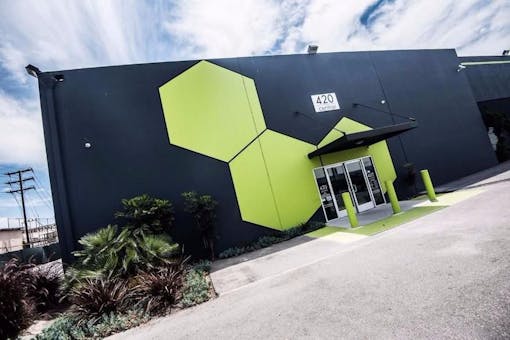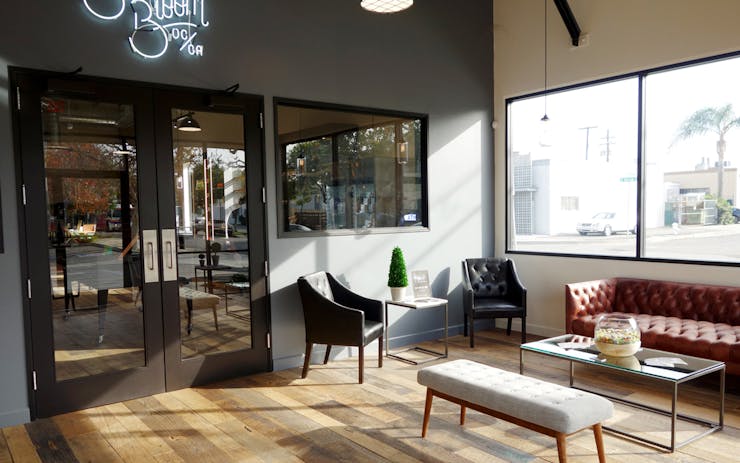Mention cannabis and the city of Santa Ana, California, and the first thing that usually comes to mind is the video.
The infamous dispensary security camera footage, shot during a police raid in June 2015, appeared to depict police officers out of control.
3 years ago, an infamous video shredded the city's reputation. But today Santa Ana is a cannabis leader.
A team from the Santa Ana PD burst open the doors of the Sky High Holistic dispensary, ordered medical marijuana patients to the floor and—based on edited clips from a dispensary attorney—started smashing security cameras. But they missed one, which kept recording.
The resulting footage showed the officers humiliating dispensary workers, including 54-year-old volunteer Marla James, the manager on duty, who is a medical marijuana patient and a legally blind amputee who uses a wheelchair. (One officer joked about kicking her “in the nub.”) The cops played darts and laughed while ripping up the store, and appeared to munch on medical marijuana edibles. The Orange County district attorney later concluded they were eating non-medicinal snacks from an employee lounge.
It was, to say the least, not a good look.
Rising From a Low Point
The Sky High raid came to represent the low point in city-cannabis relations. At the time—only three years ago—more than 100 unpermitted cannabis dispensaries were flourishing in the Orange County, CA, city. They sprouted near neighborhoods, industrial parks, and the downtown arts and historic district. Cops in the city of 350,000 people had been given orders to crack down hard.
Although there was no excuse for the behavior of the cops, the raid did not come without warning to the owners of Sky High, one of many unlicensed dispensaries that continued to operate despite the city’s efforts to shut them down.
The Sky High video changed things—on both sides.
“It affected the city and definitely the police,” said political consultant Melahat Rafiel, executive director of the Santa Ana Collective Association, an industry group that formed after the Sky High incident to advocate for a locally regulated cannabis sector. “For the industry, there was a recognition that it was time to shape up and address the issues facing us. I wanted to make sure that all of the City Council members knew who the legitimate owners were—and knew us as people with families.”

Brightening the neighborhood: 420 Central is the best-looking building in Santa Ana’s light industrial district.
Three cops in the raid were fired. They were sentenced in court to community service on misdemeanor charges of petty theft and vandalism. They later filed personnel board appeals and won reinstatement. After multiple raids, unlicensed Sky High Holistic was eventually shuttered by a city code enforcement order.
What turned the city around? Foresight, compromise, and courage from local officials.
Here’s the surprising twist in the story. In the three years since the Sky High raid, Santa Ana has emerged as Orange County’s model for a calm, well regulated, tax paying cannabis market.
Most unlicensed operations have been closed, without the use of harsh raid tactics. The city now has 19 locally authorized cannabis retail stores open for medical and adult use. Eleven more authorized locations are expected to open soon.
Shop highly rated dispensaries near you
Showing you dispensaries nearHow did it happen? What it took was a little foresight, compromise, outreach—and a lot of courage on the part of local city officials.Every Licensed Dispensary in Santa Ana
Orange County’s Changing Population
Orange County, birthplace of President Richard Nixon and home to his Yorba Linda presidential library and museum, has long been one of America’s most renowned bastions of white suburban conservatism. But seismic demographic changes, unfolding particularly in Santa Ana, have moderated its political culture.
More than 78 percent of the Santa Ana’s residents are Latino; 11 percent are Asian, 9 percent are white, and nearly half are foreign-born. Budtenders here service customers in English, Spanish, Vietnamese and Mandarin. Hillary Clinton narrowly defeated Donald Trump in Orange County in 2016.
'Instead of being a city that has to have this industry, Santa Ana became the city that wants this industry.'
Orange County’s notorious conservative firebrand – Republican Rep. Dana Rohrabacher of Huntington Beach – became famous for his staunch advocacy of cannabis reform and leadership in Congress. But Rohrabacher remains an outlier. Fighting cannabis seems to be one of the county’s most enduring conservative causes, given the city-by-city opposition to dispensaries and other marijuana businesses.
In the early 2010s, they were losing that fight. Cities across Orange County found themselves overrun with unlicensed, often sketchy medical marijuana dispensaries that flourished under California’s vague medical marijuana law, Prop. 215.
By 2011, the south county city of Lake Forest had such an influx of illegal cannabis stores that one single address targeted in a federal seizure action contained six separate dispensaries. But that raid only brought about a whack-a-mole effect. When one dispensary got shut down, two more popped up overnight in different locations. “When the feds did an intervention in Lake Forest, Anaheim, Costa Mesa and Garden Grove just exploded” with more dispensaries, said Orange County cannabis lawyer Chris Glew.
In 2014, Glew decided to stand up and fight for a better way. That year he spearheaded the industry’s Measure CC effort, a citywide initiative that would have forced the city to license a limited number of cannabis businesses. The cannabis lawyer was pleased when city officials chose not to fight—but, instead, to offer voters an alternative model for regulation.
“We saw the policymakers come around,” Glew said. “They decided that instead of being the city that has to have this industry, they would be the city that wants it.”
Reaping the Rewards
In November 2014, 57 percent of local voters supported a cannabis industry initiative—Measure CC—that could have allowed unlimited dispensaries in the city. It lost out to competing Measure BB—put on the ballot by the City Council—that authorized a regulated industry with stricter zoning rules and higher local cannabis taxes. The city’s measure prevailed because of greater voter support: 66 percent.

Sal Tinajero: Santa Ana ‘ahead of the game.’
“We are ahead of the game,” Santa Ana City Council member Sal Tinajero said after Measure BB passed. Tinajero, a nationally recognized high school history teacher, was one of the city officials advocating for an allow-and-regulate policy. “While other cities are creating bans on medical marijuana, we are creating infrastructure to allow people to get their medicine in a safe manner.”
Santa Ana’s reform measures paid off. Tax revenues increased, with few complaints over licensed cannabis operators.
But the measures also resulted in some painful blowback. The 2015 Sky High dispensary raid came about in part because of the city’s desire to allow a certain number of licensed cannabis dispensaries, and close those operating without a city permit—in accordance with Measure BB. The inexcusable conduct of the cops aside, the Sky High raid happened because Santa Ana wanted to allow licensed dispensaries—and to do so, the city had to shut down the unlicensed shops.
After the Raid
After suffering the black eye of the Sky High raid, the city continued to work on its licensing regime, moving unlicensed dispensaries out of the market without resorting to police raids and mockery.
When California legalized adult-use with Prop 64, Santa Ana was fully prepared to embrace the adult-use market.
By the time California voters approved the Proposition 64 adult use legalization initiative in 2016, other cities in Orange County (where Prop 64 passed by a 52 to 48 percent margin) had mobilized tough bans on cannabis businesses. Thirty-three cities outlawed retail sales; 32 also barred cultivation and manufacturing.
Voters in Costa Mesa approved a measure to permit cannabis manufacturing and distribution companies, but the City Council imposed a strict dispensary ban. And while residents in the liberal coastal enclave of Laguna Beach supported Prop 64 by a 62 to 38 percent margin, they voted by an even wider margin (71 to 29) to ban cannabis stores in their city.
Santa Ana, meanwhile, stuck to its game plan. And in early 2018, when California’s licensed adult-use cannabis industry opened for business, the city was ready.

Because of the city’s planning, high-end Santa Ana dispensaries like Evergreen were ready for adult-use customers in early 2018.
Taxes: $6m Last Year, $9m Next
Today, Santa Ana’s early moves to issue local licenses for cannabis stores looks like a savvy move.
With 3.2 million residents in the county, and 33 other Orange County cities not allowing retail cannabis stores, Santa Ana is reaping the tax benefits as a regional cannabis mecca.
“The growth of cannabis here is just going up month after month,” said Chris Francy, 34, owner of the city’s Bud and Bloom and OC3 dispensaries. “Santa Ana is a destination because it is the sole city that stood up.”
The city’s legal cannabis sector is a far cry from the unregulated days gone by. Today’s stores are decidedly professional and upscale, from the elegant furnishings and marble dispensary counter at Bud and Bloom, honored by Leafly as one of the “ten most beautiful cannabis dispensaries in America,” to the pop art paintings and hip-hop stylings of “The Joint.”
'On all fronts,' Santa Ana's dispensary regulation 'has been judged a success.'
With a month to go in the 2017-18 fiscal year ending July 1 (data tallies are still catching up), the city took in nearly $4 million in revenues from a 6% gross receipts tax on medical cannabis, and 8% on adult use sales that began Jan. 1. Adult use sales brought in $1.8 million in new tax revenues in just five months.
Next fiscal year, the city projects it will take in $8.8 million in local cannabis retail taxes. Another $2.6 million is expected from newly authorized commercial cultivation or manufacturing centers yet to open. In a city facing a budget shortfall of $17 million, that’s a pretty big deal.
City Council member Jose Solorio said Santa Ana went from “playing whack-a-mole to shut down illegal dispensaries” to partnering with cannabis advocates and neighborhood representatives to create a local industry and a regulated system that works.
“We have moved forward in a way to ensure that we have retail stores operating and generating the revenues they were expected to,” said Solorio. “On all fronts, it has been judged a success.”
‘Other Cities Wanted To Be Second’
There are still a small handful of unlicensed dispensaries left in Santa Ana. But the licensed cannabis industry flourishes here, with retail outlets signing city-mandated labor peace agreements and local hiring requirements. Cannabis tax dollars are ear-marked for youth programs, including summer activities, sports and after-school tutoring. They also fund a police compliance unit – a sergeant and five officers – that works with code enforcement officers.
Rafiei, former co-operator of the city’s 4th licensed dispensary, Hand N Hand Patient Care dispensary, is a veteran political operative who served as executive director of the Democratic Party of Orange County. She said Santa Ana showed political courage on cannabis as anxious neighboring cities sought sanctuary from the industry through sweeping bans rather than contemplating intricacies of regulation.
“We have moved forward in a way to ensure that we have retail stores operating and generating the revenues they were expected to,” said Solorio, a former lawmaker who served in the state Assembly from 2007 to 2013. “On all fronts, it has been judged a success.”
That result, Glew believes, will eventually lead some other Orange County cities to follow suit. “We will see other cities start to liberalize because they see the revenue opportunities,” he said. “But I don’t think there is another city in Orange County that has quite the same view on cannabis as Santa Ana.”
He said Costa Mesa, which allows licensed cannabis manufacturers, may consider retail sales in the not-too-distant future. Fullerton and Garden Grove – both with strict bans – could be candidates to follow.
“Some of the other cities aren’t necessarily opposed to cannabis regulation,” Glew said. “They just wanted to be first to be second. They wanted other cities—namely Santa Ana—to iron out the landscape.”47 Dispensary Deals in Santa Ana





